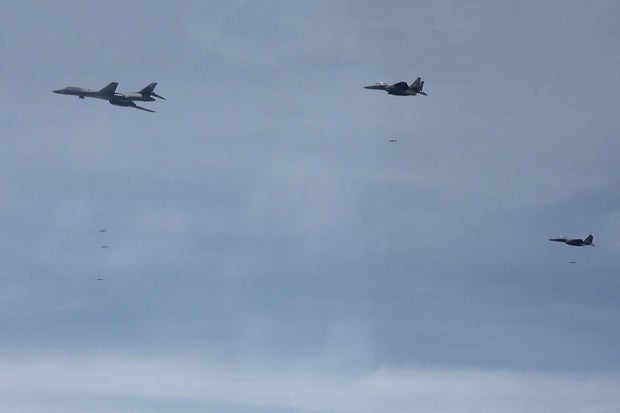The United States flew a long-range B-1B bomber over the Korean Peninsula on Wednesday for its first precision-guided bombing exercise with South Korea in seven years, the South said Wednesday.
The exercise – seen as a demonstration of strength against North Korea – comes at a time when tensions are rising due to recent launches of balloons to carry trash in relation to South Korea and other provocations.
Wednesday’s training involved other advanced U.S. and South Korean fighter jets, as well as the B-1B aircraft, the second U.S. bomber temporarily deployed over the Korean Peninsula this year. The exercise was intended to demonstrate the U.S. security commitment to South Korea and strengthen the allies’ joint defense posture, according to the South Korean Ministry of Defense, which published drill images on the social networks.
During the training, the B-1B launched joint direct attack munitions while being escorted by South Korean jets, the first such bombing exercise for a US bomber since 2017, a ministry statement said.
/AP
It said South Korean fighter jets also conducted live-fire exercises to demonstrate the country’s readiness to punish North Korea if provoked, it said.
JDAM bombs include “bunker busters”. JDAM is a guidance system that converts conventional unguided bombs into more precise GPS-guided weapons. All U.S. fighters, bombers, and drones can use JDAMs, and the munitions are among the weapons systems the United States has supplied to Ukraine to help you fight the invasion of Russia.
North Korea is extremely sensitive to exercises using bunker-busting bombs, which could threaten its leadership and complex network of tunnels and underground military structures. North Korea has already responded to flights of powerful US aircraft into South Korea with its own missile tests.
A B-1B it is capable of carrying a large payload of conventional weapons. North Korea had previously considered the bomber’s deployment proof of US hostility.
Last month, South Korea’s Ministry of Defense released an image of a US Marine Corps F-35B stealth fighter executing a maneuver over Kunsan Air Base during a joint exercise.
“The exercise reinforced our confidence to decisively overcome any adversary with an overwhelming response to provocations,” said ROK AF F-35A pilot Major Kim Seong-jun. said in a statement at the time.
Last week, North Korea floated hundreds of huge balloons to dump manure, cigarette butts, cloth scraps and battery waste across South Korea. In response, South Korea promised “unbearable” retaliatory measures and suspended a fragile military tension reduction agreement with North Korea, restoring its frontline military activities.
The suspension of the 2018 inter-Korean agreement allows South Korea to resume live-fire exercises or broadcasts of anti-North Korean propaganda over loudspeakers in border areas. Such measures will likely lead North Korea to take provocative steps in response.
Recently, North Korea launched a rocket in an attempt to put a second spy satellite into orbit, violating UN resolutions, but exploded shortly after takeoff. He also tested nuclear capable weapons for an exercise simulating a preemptive strike in South Korea and reportedly jammed GPS navigation signals in South Korea.
North Korea sent its first military reconnaissance satellite in orbit in November last year as part of efforts to build a space-based surveillance network to counter what it calls growing U.S.-led military threats. North Korean leader Kim Jong Un later said at a ruling party meeting that the country would launch three additional military spy satellites in 2024.
bol co
jogo de terror online
novela sbt ao vivo
wishlist
musica terra seca
taça png























